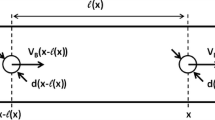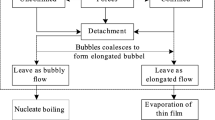Abstract
In this paper, the dynamics of bubbles and the mass transfer between bubbles and the surrounding liquid in square and circular microchannels are investigated, in the bubbly flow regime. For this purpose, a computational fluid dynamics analysis is used to carry out numerical simulations of the liquid flow and the mass transport around a spherical bubble in a square or a circular microchannel, for a stress-free or a rigid gas–liquid interface. The corresponding results are consolidated into correlations to calculate the bubble velocity and the interfacial rate of mass transfer as functions of the control parameters of the system. For each considered case, the flow structure, the concentration field around the bubble and the local interfacial rate of mass transfer are presented and shown to be intricately related.

















Similar content being viewed by others
References
Bruus H (2008) Theoretical microfluidics, vol 18. Oxford University Press, Oxford, pp 41–50 and 75
Bird RB, Stewart WE, Lightfoot EN (2007) Transport phenomena. Wiley, New York, pp 100, 636 and 677–678
Champougny L, Scheid B, Restagno F, Vermant J, Rio E (2015) Surfactant-induced rigidity of interfaces: a unified approach to free and dip-coated films. Soft Matter 11:2758–2770
Clift R, Grace JR, Weber ME (1978) Bubbles, drops and particles. Academic Press, New York
Coulson JM, Richardson JF (1991) Chemical engineering volume 2: particle technology and separation, 4th edn. Pergamon Press, Oxford
Cubaud T, Ho CM (2004) Transport of bubbles in square microchannels. Phys Fluids 16:4575
Cubaud T, Sauzade M, Sun R (2012) CO2 dissolution in water using long serpentine microchannels. Biomicrofluidics 6:022002
Dani A, Cockx A, Guiraud P (2006) Direct numerical simulation of mass transfer from spherical bubbles: the effect of interface contamination at low Reynolds numbers. Int J Chem React Eng 4(1):1542
Figueroa-Espinoza B, Legendre D (2010) Mass or heat transfer from spheroidal gas bubbles rising through a stationary liquid. Chem Eng Sci 65:6296–6309
Haas U, Schmidt-Traub H, Brauer H (1972) Umströmung kugelförmiger Blasen mit innerer Zirkulation. Chem Ing Tech 44:1060–1068
Haberman WL, Morton RK (1953) An experimental investigation of the drag and shape of air bubbles rising in various liquids. David Taylor Model Basin, Report 802
Haut B, Colinet P (2005) Surface-tension-driven instabilities of a pure liquid layer evaporating into an inert gas. J Colloid Interface Sci 285:296–305
Kashid MN, Renken A, Kiwi-Minsker L (2011) Gas–liquid and liquid–liquid mass transfer in microstructured reactors. Chem Eng Sci 66(17):3876–3897
Kawahara A, Chung PY, Kawaji M (2002) Investigation of two-phase flow pattern, void fraction and pressure drop in a microchannel. Int J Multiph Flow 28(9):1411–1435
Kim N, Evans ET, Park DS, Soper SA, Murphy MC, Nikitopoulos DE (2011) Gas–liquid two-phase flows in rectangular polymer micro-channels. Exp Fluids 51(2):373–393
Levich VG (1962) Physicochemical hydrodynamics, vol 689. Prentice-Hall, Englewood Cliffs, NJ, pp 84–85 and 467
Magnaudet J, Rivero M, Fabre J (1995) Accelerated flows past a rigid sphere or a spherical bubble. Part 1. J Fluid Mech 284:97–135
Mikaelian D, Haut B, Scheid B (2015) Bubbly flow and gas-liquid mass transfer in square and circular microchannels for stress-free and rigid interfaces: dissolution model. Microfluid Nanofluid (in revision)
Pamme N (2007) Continuous flow separations in microfluidic devices. Lab Chip 7(12):1644–1659
Ponoth SS, McLaughlin JB (2000) Numerical simulation of mass transfer for bubbles in water. Chem Eng Sci 55:1237–1255
Ratulowski J, Chang HC (1990) Marangoni effects of trace impurities on the motion of long gas bubbles in capillaries. J Fluid Mech 210:303–328
Rust AC, Manga M (2002) Bubble shapes and orientations in low Re simple shear flow. J Colloid Interface Sci 249(2):476–480
Shim S, Wan J, Hilgenfeldt S, Panchal PD, Stone HA (2014) Dissolution without disappearing: multicomponent gas exchange for \(\text{CO}_2\) bubbles in a microfluidic channel. Lab Chip 14:2428–2436
Song H, Chen DL, Ismagilov RF (2006) Reactions in droplets in microfluidic channels. Angew Chem Int Edn 45(44):7336–7356
Stebe KJ, Barthès-Biesel D (1995) Marangoni effects of adsorption-desorption controlled surfactants on the leading end of an infinitely long bubble in a capillary. J Fluid Mech 286:25–48
Sun R, Cubaud T (2011) Dissolution of carbon dioxide bubbles and microfluidic multiphase flows. Lab Chip 11(17):2924–2928
Triplett KA, Ghiaasiaan SM, Abdel-Khalik SI, Sadowski DL (1999a) Gas–liquid two-phase flow in microchannels part I: two-phase flow patterns. Int J Multiph Flow 25(3):377–394
Triplett KA, Ghiaasiaan SM, Abdel-Khalik SI, LeMouel A, McCord BN (1999b) Gas–liquid two-phase flow in microchannels: part II: void fraction and pressure drop. Int J Multiph Flow 25(3):395–410
Wylock C, Larcy A, Colinet P, Cartage T, Haut B (2010) Direct numerical simulation of the CO2 transfer from spherical bubbles to NaHCO3 and Na2CO3 aqueous solutions with clean and fully contaminated interface. Colloids Surf A Physicochem Eng Asp 365:28–35
Wylock C, Larcy A, Colinet P, Cartage T, Haut B (2011) Direct numerical simulation of bubble–liquid mass transfer coupled with chemical reactions: influence of bubble shape and interface contamination. Colloids Surf A Physicochem Eng Asp 381:130–138
Acknowledgments
The authors gratefully acknowledge Louise De Cannière for her assistance in numerical simulations. The authors also acknowledge Jean-Christophe Baret, Charles Baroud and Pierre Miquel for fruitful discussions. D.M. and B.S. acknowledge the Fonds de la Recherche Scientifique (F.R.S.–F.N.R.S.) for its financial support. This research has been performed under the umbrella of the COST action MP1106 and also took part in the Inter-university Attraction Pole Programme (IAP 7/38 MicroMAST) initiated by the Belgian Science Policy Office.
Author information
Authors and Affiliations
Corresponding author
Appendices
Appendix 1: Grid
1.1 Square microchannel
The geometry of the square microchannel is shown in Fig. 2. The principal volume is constituted of 5 subvolumes: Vol1, Vol2, Vol3, Vol4 and a zone Vol5 around the bubble. This principal volume is surrounded by smaller volumes forming a layer. These small volumes are referred to as \(V_{\text {layer}}\) hereafter. The meshing parameters of the edges presented in Fig. 2 are provided in Table 4. When an edge mentioned in Table 4 is meshed, the same mesh is applied to the other edges presented in Fig. 2, which are parallel to it and of the same length. Numerical values of the meshing parameters presented in Table 4 are provided in Table 5. For the edge cr, the number of intervals is calculated such that the ratio of the size of the last interval to the size of the first interval does not exceed 5.
Once the edges are meshed, Vol1, Vol4 and \(V_{\text {layer}}\) are meshed using Hex(ahedral) elements of type Map. It enables having the same mesh on the planes IN and OUT, which is necessary for using pseudo-periodic boundary conditions. Vol5 is meshed using Hex/Wedge elements and Vol2 and Vol3 are meshed using Tet(rahedral) elements. The Tet(rahedral) elements of Vol2 and Vol3 are combined in order to form polyhedra. It enables reducing the number of elements, improving the quality of the mesh and fastening the convergence.
\(V_{\text {layer}}\) and Vol5 are used in order to accurately capture the diffusion boundary layers at the walls of the microchannel and at the bubble surface, as explained in Sect. 3.1.
1.2 Circular microchannel
The two-dimensional geometry used for the circular microchannel is shown in Fig. 3. The principal surface is divided in 5 subsurfaces: S1, S2, S3, S4 and a surface S5 around the bubble. Smaller surfaces forming a layer are present at the top of the principal surface. These small surfaces are referred to as \(S_{\text {layer}}\) hereafter. \(S_{\text {layer}}\) and S5 are used in order to accurately capture the diffusion boundary layers at the walls of the microchannel and at the bubble surface. The edges have the same names as for the square microchannel and are created and meshed in the same way as described in “Square microchannel” in Appendix 1. Once the edges are meshed, S1, S4, S5 and \(S_{\text {layer}}\) are meshed using Quad(rilateral) elements and S2 and S3 using Tri(angular) elements.
Appendix 2: Numerical results
The values of the dimensionless control parameters and the postprocessed parameters are presented in Tables 6, 7, 8 and 9 for all the numerical simulations of the flow and the mass transport around the bubble with a stress-free or a rigid interface in the square or the circular microchannel.
Rights and permissions
About this article
Cite this article
Mikaelian, D., Haut, B. & Scheid, B. Bubbly flow and gas–liquid mass transfer in square and circular microchannels for stress-free and rigid interfaces: CFD analysis. Microfluid Nanofluid 19, 523–545 (2015). https://doi.org/10.1007/s10404-015-1578-0
Received:
Accepted:
Published:
Issue Date:
DOI: https://doi.org/10.1007/s10404-015-1578-0




